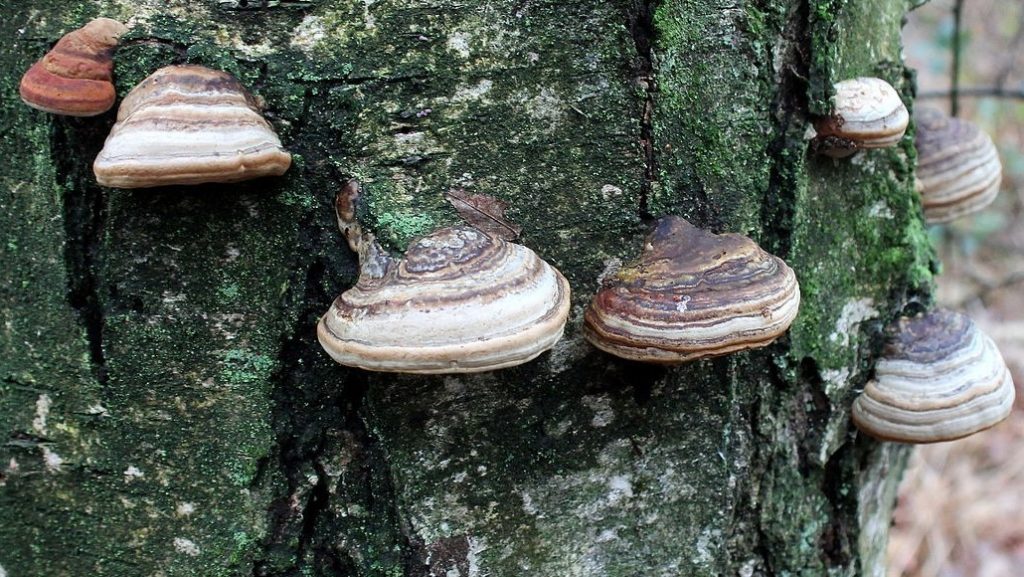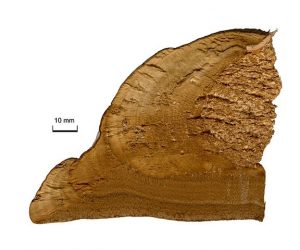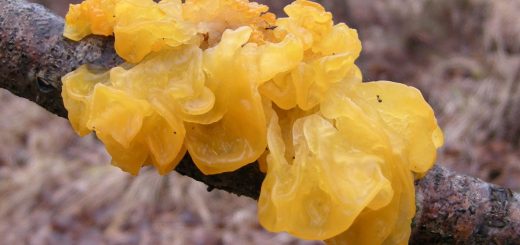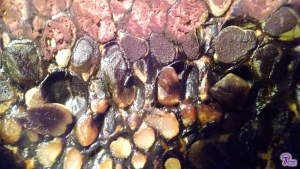#189: Fomes fomentarius, The Tinder Polypore

Fomes fomentarius is easily recognized by its distinctive hoof-shaped fruiting bodies. Photo by Heinonlein [CC BY-SA 4.0], via Wikimedia Commons (cropped).
Description
The Tinder Polypore looks like many other bracket fungi: its cap has varying shades of gray and gray-brown and is divided into many layers like a tiered cake. Its upper surface is smooth but lumpy and is quite hard. This makes the mushroom’s outward appearance very similar to old wood. The most distinctive feature of F. fomentarius is its shape. As noted above, the mushroom tends to grow in an upside-down U and is reminiscent of a horse’s hoof. The Tinder Polypore is midrange in size compared to other bracket fungi: it usually gets no more than 20cm across but occasionally grows as large as 40cm across.2–4
The relatively flat part on the underside of the Tinder Polypore is covered in tiny pores. This pore surface is whitish to light brown when fresh but slowly darkens with age. Each year – sometime in late spring through summer – a new pore surface grows on the bottom of the mushroom, so the underside regains its lighter coloration on a regular basis. This surface produces spores that are yellowish white.2–4

Cross-section of the Tinder Polypore showing old pore tubes (bottom) and thick, fibrous flesh (along the top and side edge). Public domain photo via Wikimedia Commons.
Inside, the mushroom’s flesh is brown and divided into two main areas. The first area consists of the many layers of old pores. These are easy to see because the pores form long parallel lines that point straight down. Unlike in other polypores, divisions between each year’s worth of growth are not very obvious on the inside of the Tinder Polypore. The second section lies between the outer surface and the old pores. This area is characterized by dense, undifferentiated tissue that is fibrous and softer than the rest of the mushroom.2–4 Most human uses of F. fomentarius are based on the properties of this section of the mushroom.
Ecology
F. fomentarius is parasitic on living hardwood trees and continues to decompose its host once the host dies. The mushrooms appear most often on birch trees but will also fruit on beech and occasionally on other hardwoods. You find the mushrooms growing singly or in loose groups.2–4 The Tinder Polypore grows in North America and Eurasia and is more common in northern latitudes and in any areas where its host trees are common.2–4
In my experience, dying trees with the fungus usually have only one or two Tinder Polypore mushrooms while long-dead logs have ten or more mushrooms. This is most likely a result of the fruiting bodies’ longevity: mushrooms that are no longer growing still remain on the tree for many years and the new mushrooms pop up around them. The tree often falls down during this time period, so the older mushrooms often end up tilted on their side while the newer ones grow parallel to the ground based on its new orientation.
Similar Species
There are lots of other conks that look like F. fomentarius. The easiest way to differentiate the Tinder Polypore is by looking at its shape, but that is not always helpful. If the mushroom is very young, it may not yet have developed the classic hoof shape and could easily be confused with a Ganoderma species, such as G. applanatum (FFF#070). In this case, checking the spore color will quickly establish whether your fungus is the Tinder Polypore (Ganoderma spp. have brown spore prints).3
Uses
The earliest example of humans using F. fomentarius comes from Ötzi, “The Iceman,” whose mummified body was found in the Alps in 1991.1–6 Researchers determined Ötzi lived over 5,300 years ago during the Copper Age, which was long before construction began on any Egyptian pyramids.7 When he died, Ötzi was carrying two mushrooms, one of which was the Tinder Polypore. The pieces he had were likely used to help start fires, a practice that continues to this day.1–6
The name Fomes fomentarius translates to “tinder used for tinder” and one of the common names of the mushroom is “the Tinder Muhshroom”;4 clearly, one of the mushroom’s most significant uses has something to do with fire. In fact, the processed mushroom is extremely good at catching sparks. Once processed, pieces of the Tinder Mushroom can easily catch very small sparks and smolder at a high temperature for a long time (large pieces can smolder for hours). This makes the mushroom the perfect aid for starting fires.5
Before the mushroom is used, it must be processed into ‘amadou.’ Amadou is a general term for the various types of felt-like substances obtained by processing F. fomentarius.8 Sometimes, people use ‘amadou’ to refer to the unprocessed mushroom, but that usage is less common.1 Although amadou is traditionally prepared from F. fomentarius, some other conks will also work. These alternatives, however, are not very well recorded and are less reliable.6
The simplest way to make amadou for catching a spark is to cut the fibrous flesh out of the mushroom and fluff it up a bit. Since the outside of the mushroom is so hard, you will need a sharp serrated knife or a saw to get started. Then, just remove some strips of the fibrous layer and scrape their surfaces with a knife to fluff them up a bit.5 If the mushroom is too hard to cut, you can try soaking it in water for a while to soften the outer layer.6
Another method exists that takes longer but improves the amadou’s spark-catching ability. As in the previous method, you first remove the fibrous layer. Then, you boil that layer for a day or two. After that, you beat the amadou with a wooden mallet to tease apart the fibers. You continue boiling and beating the amadou until it is soft enough or thin enough for your liking. Then, you let it dry while working it in your hands to make sure it doesn’t stiffen up. The result should be a velvety soft, felt-like fabric. Finally, the amadou can be treated with a nitrogen-rich substance like saltpeter or urine. This last step ensures the amadou can catch even the smallest and coldest sparks.8

Amadou derived from the Tinder Polypore has many uses, including making these unique hats! Photo by Brudersohn [GFDL or CC-BY-SA-3.0], via Wikimedia Commons
The Tinder Polypore mushroom can be used for certain things without having to first prepare amadou. As a medicinal, F. fomentarius is supposed to help treat various maladies of the gastrointestinal, renal, and reproductive systems. The fungus can also be burned to create punk ash, which is mixed with tobacco to increase the tobacco’s effects (see FFF#129 for how that works in Phellinus igniarius).1
Taxonomy
Not surprisingly, F. fomentarius belongs to the core family of polypores. Many polypores are wood decomposers that produce woody, perennial mushrooms, so this fungus is right at home in that family. Interestingly, in most of North America F. fomentarius is the only member of its genus found in the region. Other Fomes species are found in Florida and parts south, but these are absent from the bulk of the United States and Canada.1
| Kingdom | Fungi |
| Division | Basidiomycota |
| Subdivision | Agaricomycotina |
| Class | Agaricomycetes |
| Order | Polyporales |
| Family | Polyporaceae |
| Genus | Fomes |
| Species | Fomes fomentarius (L.) Fr.9 |
See Further:
http://botit.botany.wisc.edu/toms_fungi/dec2001.html
http://www.mushroomexpert.com/fomes_fomentarius.html
http://www.messiah.edu/oakes/fungi_on_wood/poroid%20fungi/species%20pages/Fomes%20fomentarius.htm
http://paulkirtley.co.uk/2011/easy-way-to-use-fomes-fomentarius-as-tinder/
Citations
- Volk, T. J. Tom Volk’s Fungus of the Month for December 2001. Tom Volk’s Fungi (2001). Available at: http://botit.botany.wisc.edu/toms_fungi/dec2001.html. (Accessed: 26th May 2017)
- Kuo, M. Fomes fomentarius. MushroomExpert.Com (2010). Available at: http://www.mushroomexpert.com/fomes_fomentarius.html. (Accessed: 26th May 2017)
- O’Reilly, P. Fomes fomentarius (L. ex Fr.) Kickx- Hoof Fungus. First Nature Available at: http://www.first-nature.com/fungi/fomes-fomentarius.php. (Accessed: 26th May 2017)
- Emberger, G. Fomes fomentarius. Fungi Growing on Wood (2008). Available at: http://www.messiah.edu/oakes/fungi_on_wood/poroid%20fungi/species%20pages/Fomes%20fomentarius.htm. (Accessed: 26th May 2017)
- Kirtley, P. The Easy Way to Use Fomes Fomentarius as Tinder. Paul Kirtley’s Blog (2011). Available at: http://paulkirtley.co.uk/2011/easy-way-to-use-fomes-fomentarius-as-tinder/. (Accessed: 26th May 2017)
- Labiste, S. Substitutes for Tinder Fungus. Primitive Ways Available at: http://www.primitiveways.com/Amadou%20substitutes.html. (Accessed: 26th May 2017)
- Ötzi the Iceman. South Tyrol Museum of Archaeology
- Hordon, M. How to Make Amadou Tinder. Shark Designs Available at: http://www.sharkdesigns.co.uk/bushcraft/bushcraft_articles_and_advice/FIRE/how_to_make_amadou_tinder_fungus_article.html. (Accessed: 26th May 2017)
- Fomes fomentarius. Mycobank Available at: http://www.mycobank.org/Biolomics.aspx?Table=Mycobank&Rec=10408&Fields=All. (Accessed: 26th May 2017)








![#011: Characteristics of Kingdom Fungi [Archived]](https://www.fungusfactfriday.com/wp-content/themes/hueman/assets/front/img/thumb-small-empty.png)


4 Responses
[…] Conk. Many conk-forming fungi produce hoof-shaped conks (for example, Fomes fomentarius, FFF#189), but those produced by G. applanatum are remarkably […]
[…] Some of the most common woody polypores include the Artist’s Conk (Ganoderma applanatum) and Fomes fomentarius. In the warmer seasons you can also find many fleshy polypores. These include the Chicken of […]
[…] Artist’s Conk.3 Many woody polypores produce hoof-shaped conks (for example: Fomes fomentarius, FFF#189), but G. applanatum mushrooms are remarkably flat. MycoBank lists the current name of G. applanatum […]
[…] to mind are Phellinus everhartii (which is very similar but grows on oaks), Fomes fomentarius (FFF#189) and Fomitopsis pinicola. The Cracked Cap Polypore’s dull brown pore surface and growth on Black […]